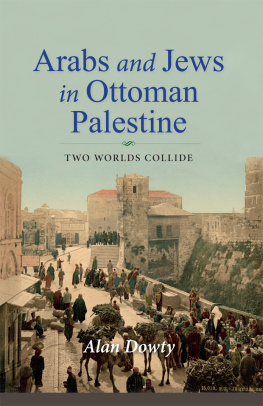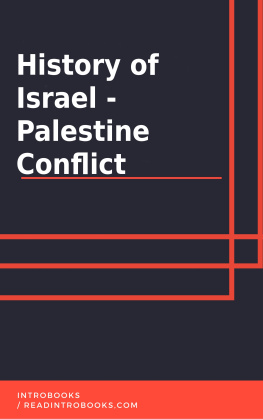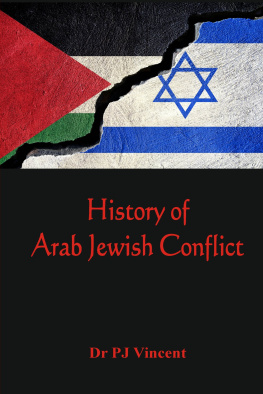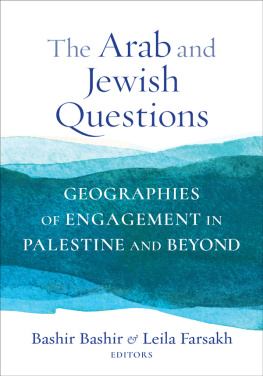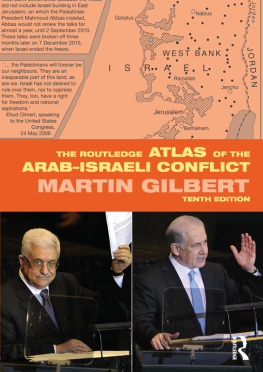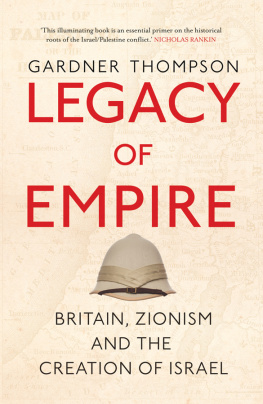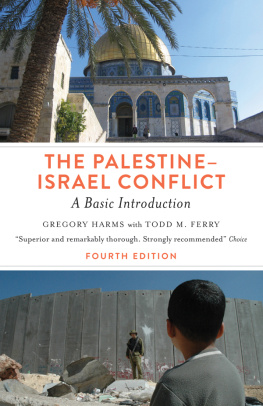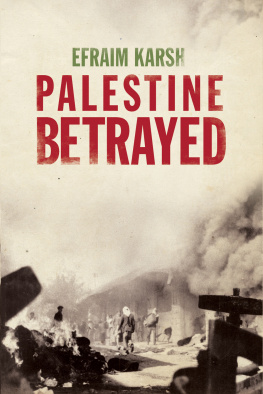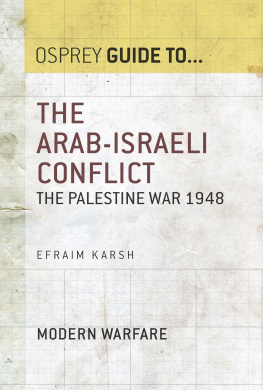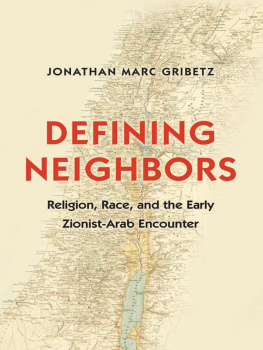Table of Contents
Guide
ARABS AND JEWS IN OTTOMAN PALESTINE
PERSPECTIVES ON ISRAEL STUDIES
S. Ilan Troen, Natan Aridan, Donna Divine, David Ellenson, and Arieh Saposnik, editors
Sponsored by the Ben-Gurion Research Institute for the Study of Israel and Zionism of the Ben-Gurion University of the Negev and the Schusterman Center for Israel Studies of Brandeis University

This book is a publication of
Indiana University Press
Office of Scholarly Publishing
Herman B Wells Library 350
1320 East 10th Street
Bloomington, Indiana 47405 USA
iupress.indiana.edu
2019 by Alan Dowty
All rights reserved
No part of this book may be reproduced or utilized in any form or by any means, electronic or mechanical, including photocopying and recording, or by any information storage and retrieval system, without permission in writing from the publisher. The paper used in this publication meets the minimum requirements of the American National Standard for Information SciencesPermanence of Paper for Printed Library Materials, ANSI Z39.48-1992.
Manufactured in the United States of America
Cataloging information is available from the Library of Congress.
ISBN 978-0-253-03865-4 (cloth)
ISBN 978-0-253-03868-5 (ebook)
1 2 3 4 5 23 22 21 20 19
CONTENTS
THIS BOOK HAS HAD AN unusually long period of gestation. As a result, it overlaps two periods as a visiting fellow at the Oxford Centre for Hebrew and Jewish Studies. Much of the basic research was done, therefore, in the Bodleian Libraries at the University of Oxford and in the Oxford Centres own Kressel Archive. I am grateful to the Oxford Centre for providing me with an excellent environment in which to undertake this projectand at the same time I am also relieved that there is, at long last, something to show for it.
The Azrieli Institute for Israel Studies, at Concordia University, also provided me with a visiting fellowship at a key time in the books development. My thanks to the institute and to its director, Csaba Nikolenyi.
In addition, much of the primary material came from the Central Zionist Archives, in Jerusalem, and from archival holdings in the National Library on the Hebrew University campus, during periods of residence in Jerusalem.
My intention with this book was to work from the ground up, tracking the development of Arab-Jewish conflict in Ottoman Palestine in large part through memoirs, letters, diaries, and other primary sources of contemporaries. This does, however, raise an issue of an inherent imbalance. Such sources are abundant on the Jewish side; in fact, a huge number of them are available in published formats. There are far fewer equivalent Arab sources for this period, especially before the rise of Arab nationalism in the years shortly before World War I. There are other kinds of Arab (and Turkish) sources that have been fully utilized by Palestinian and other scholarsnewspapers have been thoroughly surveyed by Rashid Khalidi; diplomatic and governmental documents by Neville Mandel and Alexander Schlch; court records by Yuval Ben-Bassat. I have drawn extensively from these studies and others, but still there remains less direct Arab testimony about the localized clashes that form a good part of the story. The Jewish testimonies do include some serious attempts to describe and understand their Arab neighbors, but this is not the same as having direct expressions from these neighbors.
Readers will also note that there is relatively more emphasis on the first aliya (wave of Jewish immigration to Palestine), 18821905, than on the second aliya, 19051914. In part this could be justified on grounds that the second aliya, though covering a shorter period, has received much more attention from historians and thus needs less elaboration. In fact, I come away from this study feeling that the first aliya has been unjustly minimized, and even denigrated, in evaluations of its role in Arab-Jewish relations and in the rise of Zionism generally. This book can therefore be seen as part of an effort to redress the previous fixation on the second aliya and even to call into question the sharpness of the supposed differences between the two waves of immigration. What happened between Arabs and Jews in the last decade before World War I was, by and large, an extension of relations from the preceding quarter century.
For the convenience of the reader, wherever possible, I have made use of the abundance of published primary sources to cite and quote from published versions and English translations. Unless otherwise noted, all other English translations are my own. I have used the Hebrew Language Academy system to transliterate Hebrew to the Latin alphabet and the American Library AssociationLibrary of Congress system for transliteration of Arabic. Since the Jewish year does not correspond to the Western calendar year, dates of publication for some Hebrew-language sources will appear as two successive years.
ARABS AND JEWS IN OTTOMAN PALESTINE
COULD A SHARP-EYED OBSERVER OF mid-nineteenth-century Palestine have detected hints of the future struggle between Jews and Arabs over this land?
It seems unlikely. The fact is that none of the observers at the time foresaw the conflict that was yet to come. Before the first wave of Jewish immigration in the 1880s, the most vivid portraits of Palestine came from European or American travelers who saw little promise for either Jews or Arabs in the Promised Land. The tiny and impoverished community of Jews, subsisting mainly on charity, hardly seemed a contender for territorial domain, and the Arab population living under Turkish rule appeared devoid of political identity or ambitions. Neither future contender made much of an impression; it was, in the eyes of outsiders, a dismally set stage without a credible script or convincing actors.
A MOURNFUL DESERT
Western observers left scathing observations about what they saw. From their blinkered perspective, the Palestinian provinces of the Ottoman Empire were marked by bleak desolation, rampant lawlessness, and breathtaking misery. Those religiously inclined saw this as divine judgment on non-Christians. William Thomson, an American Protestant missionary who spent over 40 years in Beirut, wrote, after an 1857 visit to Palestinian areas, that their mournful deserts and mouldering ruins rebuke the pride of man and vindicate the truth of God.
Secular visitors could be just as harsh. A 31-year-old Mark Twain, known at this point only for his short stories and humorous travelogues, reached Palestine in 1867 during his five-month voyage, immortalized in The Innocents Abroad. Unmoved by biblical sentiments that inspired others, he concluded: Of all the lands there are for dismal scenery, I think Palestine must be the prince.... Palestine sits in sackcloth and ashes. Over it broods the spell of a curse that has withered its fields and fettered its energies. The barrenness of the hills was matched by the repulsiveness of the cities: thoroughly ugly, and cramped, squalid, uncomfortable, and filthy.
It is not too surprising that visitors from the verdant lands of Europe or America would be struck by the rocky aridity of much of the Middle East; similar observations are made today. But nineteenth-century observers were also struck by the sparse population they encountered, even in places that looked more inviting for settlement. Riding across the Plain of Sharon in the vivid green of early spring in 1873, Reverend Samuel Manning, American author and illustrator of numerous travelogues, noted the wildflowers on all sides but remarked that this fertile plain which might support an immense population is almost a solitude. By the Sea of Galilee, where entire fleets sailed in ancient times, Manning found only a single filthy ruinous townTiberiashalf-a-dozen wretched villages, and the black tents of the Bedouins. In the whole Jordan Valley, he claimed, there is not a single settled inhabitant.
Next page
